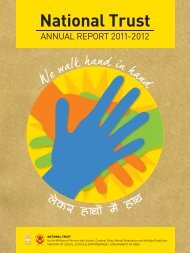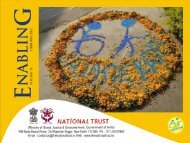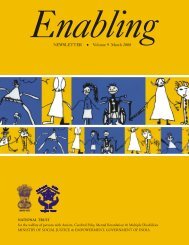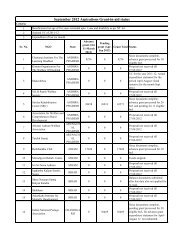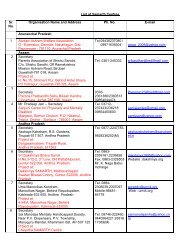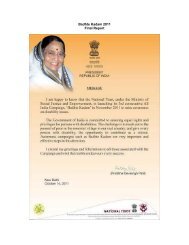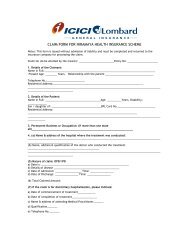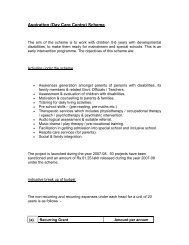INTRODUCTION - National Trust
INTRODUCTION - National Trust
INTRODUCTION - National Trust
You also want an ePaper? Increase the reach of your titles
YUMPU automatically turns print PDFs into web optimized ePapers that Google loves.
So many children, particularly those with less severe developmental delays, will show<br />
a steady improvement with the educational and behavioural approaches generally<br />
available, and once they are in a program their parents become delighted with their<br />
gains. There are not enough programs around, and not enough professionals familiar<br />
with them; waiting lists are shockingly long. Behavioural approaches (“ABA”) seem<br />
to offer the best hope at present, but there are many other innovative and sincere<br />
approaches - the “Miller method”, “Giant Steps”, “floor time”, “sensory integration<br />
therapy” which some professionals and parents feel are sometimes helpful. We need<br />
much more research to make our decisions on evidence rather than hope or faith.<br />
But for many children there seems to be no progress at all. A large proportion of<br />
children develop epilepsy (seizures), and there is a group which becomes worse as<br />
teenagers. When progress is bad, and this is very often when the child is very far<br />
behind developmentally and the behaviour impossible to live with, it is tempting to<br />
try unorthodox and quite unproven ways of helping. I would include chiropractors,<br />
naturopaths, iridologists, and reflexologists amongst those only contribution to these<br />
children and their families is the production of false hopes! If you are tempted to<br />
follow these routes, I hope you will let me know so we can discuss worries.<br />
8. What about diet, and vitamins ?<br />
Because we do not know the “cause” of the autistic spectrum disorders it possible<br />
that at least some cases are caused by biochemical disturbances in the brain. Many<br />
biochemical disorders can respond to changes in diet -diabetes is a good example but<br />
there are many others. There is evidence that some autistic people have biochemical<br />
differences in their brains, so it is quite reasonable to experiment with substances that<br />
might change brain chemistry - these may be vitamins, metals, other foodstuffs or<br />
drugs.<br />
Because many autistic children seem to have too much serotonin, and bananas are<br />
very rich in this substance, it is probably wise to avoid this fruit -or at least to note<br />
down very carefully any changes that seem to follow eating a lot of bananas. We<br />
know that children short of iron concentrate poorly, so that any hyperactive or<br />
inattentive child deserves the simple blood test to measure the ion-carrying protein<br />
ferritin, or a course of iron tablets.<br />
One theory suggests that some autistic people may absorb milk (casein) and wheat<br />
(gluten) peptides which resemble natural neurotransmitters and have a bad effect on<br />
brain function. Some parents keep their children on a diet free of milk and wheat -but<br />
the evidence that this helps is lacking.<br />
One expert on autism, Dr. Bernard Rimland, has published evidence that high doses<br />
of vitamin B6 (thiamine) and aluminium have helped many autistic children; many<br />
28



